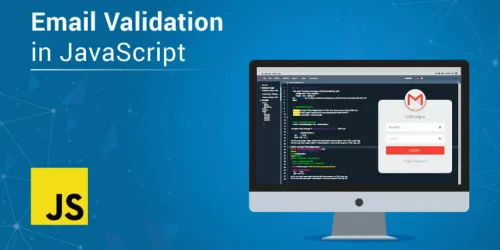In the dynamic realm of web development, data accuracy is crucial for maintaining the integrity of your applications. JavaScript, one of the fundamental languages of the web, plays a significant role in ensuring that user data, especially email addresses, is entered correctly. In this comprehensive guide, I, as an expert in JavaScript, will take you on a journey into mastering email validation in JavaScript. We will delve into various techniques, practical code examples, best practices, and more, ensuring that your JavaScript applications handle email validation with precision and enhance the user experience.
The Importance of Email Validation
Email validation is not just a technicality; it's a critical component of web forms for several reasons:
1. Data Accuracy: Validating email addresses ensures that the data collected is accurate and error-free, reducing inconsistencies in your database.
2. User Experience: Providing real-time feedback to users regarding invalid email inputs enhances their experience by preventing submission errors.
3. Security: Proper email validation can help safeguard your application against malicious inputs and potential vulnerabilities.
4. Communication Efficiency: Accurate email addresses improve the efficiency of communication with users through email-based notifications or updates.
Common Techniques for Email Validation in JavaScript
There are multiple techniques for email validation in JavaScript, and each has its advantages and limitations. Let's explore some of the most commonly used methods.
1. Regular Expressions (Regex)
Regular expressions are a powerful tool for email validation. They allow you to define a pattern that matches valid email addresses. Here's a basic example:
const emailPattern = /^[a-zA-Z0-9._-]+@[a-zA-Z0-9.-]+\.[a-zA-Z]{2,4}$/;
You can then test an email address against this pattern:
if (emailPattern.test(email)) {
// Valid email address
} else {
// Invalid email address
}
Regex provides flexibility and precision in email validation but can be complex to write and maintain for all edge cases.
2. HTML5 input Element with type="email"
HTML5 introduced the input element with a type attribute of email, providing built-in email validation in modern browsers. While it's user-friendly and accessible, it may not cover all validation scenarios.
<input type="email" id="email" name="email" required>
3. JavaScript Libraries
Several JavaScript libraries and plugins are available to simplify email validation. These libraries often provide pre-defined validation rules and user-friendly error messages. Examples include Parsley.js and validator.js.
Practical Email Validation with JavaScript
Implementing email validation in your JavaScript applications is a step-by-step process. Here's a basic example using JavaScript and regular expressions:
const emailPattern = /^[a-zA-Z0-9._-]+@[a-zA-Z0-9.-]+\.[a-zA-Z]{2,4}$/;
function validateEmail(email) {
return emailPattern.test(email);
}
// Example usage:
const email = '[email protected]';
if (validateEmail(email)) {
console.log('Valid email address');
} else {
console.log('Invalid email address');
}
In this example, we define a function validateEmail that checks if an email address matches the specified pattern.
Best Practices for Email Validation in JavaScript
To ensure effective email validation in JavaScript, consider the following best practices:
1. Use Established Patterns: When using regular expressions, consider established patterns for email validation to cover a wide range of valid email addresses.
2. Provide User Feedback: Always provide clear and user-friendly error messages to guide users when their input is invalid.
3. Validate Server-Side: While client-side validation is helpful for user experience, always perform server-side validation to ensure security.
4. Test Thoroughly: Test your email validation code with various email addresses, including edge cases, to ensure accuracy.
5. Keep It Simple: Choose an email validation method that best suits your application's needs and complexity. Sometimes a simple approach is sufficient.
Frequently Asked Questions
1. Can I rely solely on client-side email validation in JavaScript?
While client-side validation is essential for user experience, it should always be accompanied by server-side validation for security reasons.
2. Which email validation method is the most accurate?
Regular expressions (Regex) provide the most precise email validation, but they can be complex to implement and maintain.
3. Are there JavaScript libraries for email validation?
Yes, there are JavaScript libraries like validator.js and Parsley.js that simplify email validation by providing pre-defined rules and error messages.
4. What is the HTML5 input element with type="email"?
The HTML5 input element with type="email" provides built-in email validation in modern browsers, making it user-friendly and accessible.
5. How can I customize error messages for email validation?
You can customize error messages by defining your own error messages in JavaScript or by using a JavaScript library that supports custom messages.
In conclusion, mastering email validation in JavaScript is essential for ensuring data accuracy and providing an optimal user experience. By following the principles and best practices outlined in this comprehensive guide, you can implement precise email validation in your JavaScript applications, making them more reliable and user-friendly. Stay updated with the latest developments in JavaScript to keep your web applications at the forefront of data validation and user interaction.



